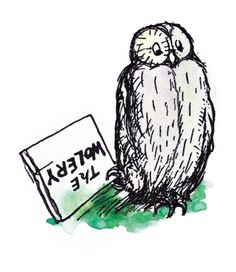Aspects of Bagpuss
If you are a reader of a certain age, Bagpuss will need no introduction. In fact, the ‘saggy old cloth cat’, his owner Emily and his motley colleagues in the ‘very unusual shop’ are probably just as colourful and alive to you as they were the first time you saw them, several decades ago. This famous children’s programme, which was voted the most popular of all time in 1999, has seeped into the collective subconscious of its viewers – and, as a result, is woven into the very cultural fabric of the UK. Kids’ TV it may be, but it still means a great deal to many adults.
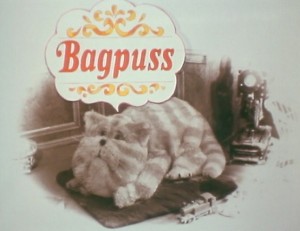
Bagpuss uses a blend of still photography, illustration and stop-motion animation to portray a 1900s bric-a-brac shop inhabited by Bagpuss, a ‘saggy old cloth cat’, and his friends – Gabriel the toad, Madeleine the rag doll, Yaffle the woodpecker and the mice on the ‘marvellous mechanical mouse-organ’.
Each episode follows exactly the same format. Emily, Bagpuss’s human owner, finds a lost ‘thing’ that she brings into the shop. Through discussion, storytelling, song and handicraft, Bagpuss and Co restore the ‘thing’ to its proper state, or discover its purpose. It is then placed in the shop window, so that its rightful owner can come in and collect it (an event we never witness, but are nonetheless convinced will occur).
The programme was created by Oliver Postgate and Peter Firmin around 1973, following on from their earlier famous successes Noggin the Nog and The Clangers. Postgate developed the concept, narrated the action and played Bagpuss. Firmin fashioned the characters, sets and artwork and also contributed some ideas, while folk singers John Faulkner [1] and Sandra Kerr wrote and played the music, and also voiced Gabriel and Madeleine.
The 13 episodes were first broadcast by the BBC in 1974 and repeated twice a year until 1987 [2], a total of 27 times – far more than many more eminent adult productions of the 70s, which were often discarded to save storage space [3]. This exposure was crucial, because it meant that Bagpuss was instilled its young viewers’ minds through repetition, even before the advent of VHS or on-demand viewing.
Recall was further aided by the reassuringly rigid structure: roughly the first two minutes setting the scene, and the closing 60 seconds in which Bagpuss and his friends go to sleep, are absolutely identical footage for each 15-minute episode.
However, Bagpuss’ popularity isn’t just down to repetition, or even nostalgia. The reason for its enduring appeal is its depth of meaning, cultural resonance and intellectual weight.
I have never felt that the twelve or so worlds which Peter Firmin and I put together are in fact creations. We may have altered the scenery a bit, looked at it from a different angle perhaps, and the worlds have certainly taken on a life of their own. Even so, they are all really versions of this one, with troubles and delights that we can recognize – if they weren’t they wouldn’t be interesting.
Oliver Postgate [4]
Bagpuss is simultaneously worldly and otherworldly, using familiar things in unfamiliar ways. Unlike so much modern children’s TV, with its primary-colour simplicity, wide-eyed didactic zeal and moralistic finger-wagging, Bagpuss is hazy, vague and speculative, meandering along with the thoughts of its protagonist between factoids, ideas and fragments of cultural flotsam, all of which have the same feel of found objects as the ‘things’ that provide their central theme.
The programme is clearly the work of auteurs who were granted final cut without having to explain or justify their eccentricities – mirroring, in a small way, the brief flowering of high-calibre liberal filmmaking in Hollywood [5] and classic UK television (comedy particularly) during the early 70s.
What works wonderfully is if people who know what they are doing, or know what they are doing most of the time, are allowed to trust their gut. That’s when you get interesting television.
John Cleese [6]
Like other contemporary works produced this way, Bagpuss has a richness, complexity and ambiguity that supports multiple critical readings. In this piece, I aim to explore a few of them, beginning with the main characters.
Bagpuss himself
Like characters in myths or fables, the inhabitants of Bagpuss & Co each have salient character traits that largely define them. However, Bagpuss stands out as by far the most rounded.
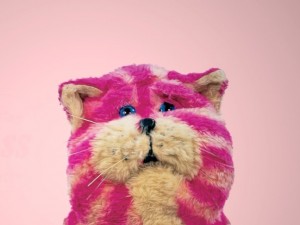
Soft and saturnine, he sets the tone for the whole programme, giving it an ambient mood of placidity, kindness and curiosity. Having Postgate speak the parts of both Bagpuss and the narrator blurs the boundaries between the two, making Bagpuss a sort of authorial avatar and lending him a quasi-godlike air, despite his humility and unprepossessing physique (‘baggy, and a bit loose at the seams’).
At the same time, though, Bagpuss has some of the affable bafflement of Captain Mainwaring from Dad’s Army [7] – always slightly taken aback by the ‘things’ and the requests he receives to think about them, but too warm to ever become too pompous. He is a fantasy figure of seniority: an idealised version of the child’s much-loved teacher or relative, a blend between grandfather and favourite toy.
Crucially, though, Bagpuss’ powers of imagination are formidable. One writer describes him as ‘the dreamer, the existentialist hero, through whose eyes everything is seen, and who, through a process of doubt and questioning, manages to synthesise all possible reasonings and pathways into one affirmative act’. [8]
Bagpuss certainly is an existentialist hero in terms of his constraints, if not his actual philosophy.Though a dreamer par excellence, he can only actually dream while awake – and even then, only when directed to by another character as part of the quest to understand the ‘things’. His dreams are a tool, a means to an end, rather than a reflection of his own freedom, or a means to attain it.
In fact, Bagpuss may even be a prisoner – confined, apparently eternally, in the shop along with his friends, condemned to relive his previous life in imagination, never evolving or escaping. This recalls the plight of the characters in Sartre’s Huis Clos (‘No Exit’ or ‘Behind Closed Doors’). Like Joseph, Inès and Estelle, Bagpuss must come to terms with the fact that his being, however heroic, can only be realised through the will and consciousness of others: Emily, who commands him to wake, and his fellow characters, who command him to think. Without them – that is, ‘once he [is] asleep’ – he is mere matter, ‘a saggy old cloth cat’.
Professor Yaffle
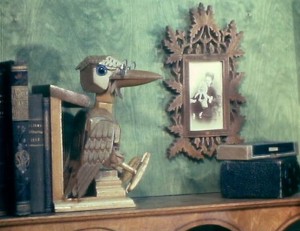
Yaffle, the ‘carved wooden bookend in the shape of a woodpecker’, represents the voice of science and scepticism. Hence it is he who, climbing down off his bookend, is entrusted with the initial assessment of ‘what it is that Emily had brought’.
Taking nothing on trust, he insists on rationality and concrete proof, scoffing at speculation, superstition and – above all – silliness. As a bookshelf fixture himself, he naturally values written learning, and in fact is often proved right. But his blinkered empiricism can also lead him up the wrong path, as in ‘The Mouse Mill’:
Yaffle: Nerp, nerp, nerp. A box. A box of what, I wonder? Oh, that’s odd – a box with a front door!
Gabriel: That’s not a box. It is a house!
Yeffle: No, no, that’s a box! Who would live in a box like that?
Mice: It’s a mouse house!
Yaffle’s weakness is his woodenness, his inflexibility. Perhaps he was once a real woodpecker, but sacrificed his natural form to gain human knowledge (and steel-rimmed specs), exchanging a walk-on part in the woods for a lead role on a shelf. He is the saddest character in many ways, because he is so isolated by his own principles and reflexive formality – rather like Stevens the butler in The Remains of the Day.
The mice on the mouse-organ
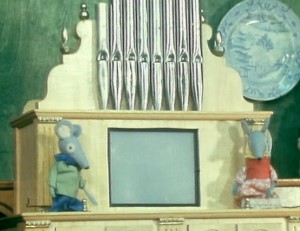
Like Yaffle, the mice are also carved from wood. However, when Bagpuss wakes up, they become frenetic fabric creatures – the only characters to change their form in this way. Once animated, they fulfil a dual role: working the mouse organ and restoring the ‘things’ for some of the time, and making mischief for the rest – a role in which they’re frequently at odds with Yaffle, although Madeleine also upbraids them for some misdemeanours. They generally act in unison, although Charlie mouse is the most distinct among them, intermittently exhibiting autonomy and a feisty, insolent personality.
The fact that Bagpuss should be a natural predator of the mice is never remarked upon – but the laws of the toybox often differ from those of the jungle.
Madeleine the rag doll and Gabriel the toad
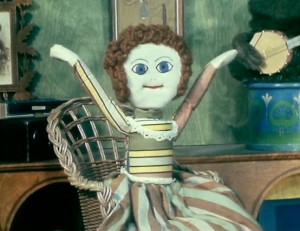
Madeleine is the only humanoid in the shop, and the only female apart from some of the mice. With a permanent, sewn-on welcoming smile and arms spread wide, she functions as a mother figure to the others, particularly the mice, as well as providing a link (through song) to nature.
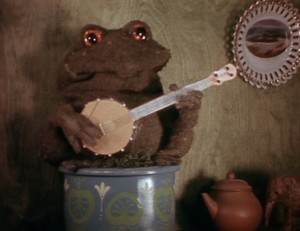
Gabriel the toad generally has less to say (and sometimes just croaks), but fulfils a complementary function, often duetting with Madeleine. Their harmony may represent marriage, parenthood and the yin-yang complementarity of the genders, in contrast to the baggily sexless Bagpuss, the ascetic Yaffle and the childlike mice.
At certain times, the group reflects the key figures in a child’s life, with Madeleine and Gabriel as mother and father, the mice as children, Yaffle as teacher or pedantic uncle (often put firmly in his place) and Bagpuss as grandfather. This gives the programme a faint undertone of a family gathering in an unfamiliar house, populated by other people’s oddments and ornaments, always so mystical and exotic to the visiting child.
Emily
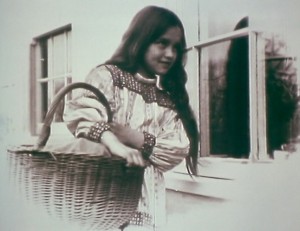
Emily is a straightforwardly human little girl (played by Firmin’s daughter), but her role in the drama is intriguing. Perhaps it is she, rather than Bagpuss, who is God – or perhaps Godot, eternally awaited but never seen? [9] She certainly is godlike in the sense of imparting purpose to the characters (by finding and providing the ‘things’), and bringing them to life (by casting her spell on Bagpuss).
Unlike Bagpuss, though, she is as inscrutable and ineffable as any deity, known only through fixed images and reported words. Bagpuss is her chosen prophet, privileged alone to encounter her in the ‘real’ (sepiatoned) world as well as being incarnated in the lower world of the shop.
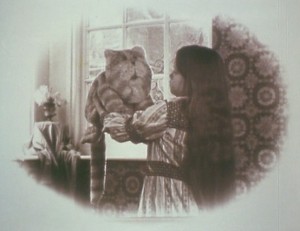
To the other characters, the ‘real’ world may seem like a supernatural realm; a higher plane of existence to which they cannot aspire. Though their life be magical, they can only live it within the confines of the shop – that is, the physical world.
More probably, the shop alludes to the inner world of Emily’s imagination, over which she has godlike authority. Here anything can happen, as long as it can be imagined: the child’s toys are outside herself, yet they can only think her thoughts and speak her words. In that sense, they are aspects of herself, just as Winnie the Pooh, Piglet and friends [10] are aspects of Christopher Robin. Hence Owl, for all his vaunted intelligence, can only spell as well as a five-year-old.
It’s always interesting to see which toy a child nominates as their ‘special one’ – the one that always comes first, always sleeps beside, can never be lost. Often an animal, the special toy shares some characteristics with the magical familiar [11] or pagan totem [12] – an animal spirit who functions variously as protector, confidant and conduit for forces ancestral or divine. In all probability, our choice of special toy says – perhaps even determines – a great deal about our character. It tells us much about Emily’s (and Postgate’s) worldview that the gentle, curious Bagpuss is its guiding spirit. In turn, he influences her to be a loving, not a vengeful god (‘…but Emily loved him’).
The shop and the ‘things’
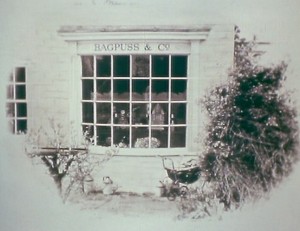
In a way, the Bagpuss & Co shop is itself is also a character, serving as a portal to the world of fantasy, just as the fancy-dress shop did in Mr Benn [13]. This is completely appropriate, since shops loom so large in the world of the child. Along with libraries, they are among the first non-home buildings we get to visit, and are often places of pleasure or excitement. In the days before the internet and video games, when children’s TV was rationed to a couple of hours a day, the newsagent held the promise of both diversion and sensuality, in the form of comics and confectionery respectively. Even grown-up places such as hardware or furniture shops could be fascinating, in their way. Like the tablet or console today, the shop was an oasis of colour, life and possibility – a manifestation of the child’s personality in the drab, careworn world of the adult.
As for the ‘things’, they are invariably handmade, and nearly all fashioned from organic materials. Often, they need to be repaired or transmuted through further handicraft. Even if Postgate had made 100 episodes, it’s clear that no mass-produced objects would ever have featured. The ‘things’ must be unique in every sense: in their physical being, their ownership and the story that lies behind them. This uniqueness re-emphasises the self-sufficiency and introversion of the shop-world. Nothing here can be found elsewhere, and nothing needs to be; we are wandering among Marlowe’s ‘infinite riches in a little room’ [14] – the enclosed yet limitless play-world of the imaginative child.
Bagpuss the storyteller
Obviously, Bagpuss’ storytelling is no ordinary storytelling. First, his words often work sympathetic magic; for example, when he tells of his ship being magically repaired by mermaids, the ship in a bottle before him is correspondingly restored. Second, his thoughts appear above his head, in a literal representation of the storyteller’s power to paint with words, to make dreams visible. (Not for nothing is Postgate’s autobiography entitled Seeing Things.)
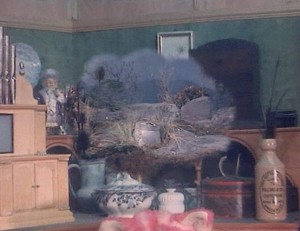
In ‘The Ballet Shoe’, Charlie Mouse expresses his wish to use the shoe as a boat, and sail it down a stream. The mice duly squeak ‘Row, row, row your boat’, before Gabriel gamely spins his own fantastical variant in which two mice row a ballet shoe into the kitchen of a stately home, ending up diving into a Stilton cheese and bathing in orange squash.
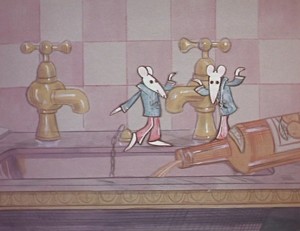
From the familiar – a shoe, a nursery rhyme – is conjured the unfamiliar, the fantastical. The message is that if life truly is ‘but a dream’, then ‘we have the power, as dreamers, to make it beautiful’ [15] – to tell our own stories and to go wherever we want in our imaginations.
Without going out of my door
I can know all things on Earth
Without looking out of my window
I could know the ways of Heaven
George Harrison, lyric to ‘The Inner Light’
Although Postgate was no dropout, this notion of psychic travel and vision reflects the post-60s assimilation of countercultural ideas into the mainstream – what happened when the hippies got jobs. In this respect, Bagpuss is a more sober, British cousin of the madcap, hallucinatory Magic Roundabout.
However, Bagpuss’s storytelling is always purposeful, because it serves to discover the truth of the ‘thing’. As in detective fiction from Philip Marlowe to The X Files, the single, objective, physical truth is out there, waiting for us to find it. Beginning with the physical evidence before him, Bagpuss pieces together the puzzle by drawing on his own experience and knowledge, plus the idiosyncractic views of his fellow cops in the precinct. In some cases, this is mirrored by the physical re-integration of the ‘thing’ – as when the shattered statues of the Smallest Giant, or the nodding turtle and the wise man, are magically made whole again once their stories have been told.
Worlds within worlds
Considering its intended audience, it’s perhaps surprising that Bagpuss exhibits an ontological subtlety normally associated with sophisticated adult works such as the fictions of Jorge Luis Borges [16] or the Christopher Nolan film Inception.
The opening of each episode evokes the turn of the 20th century through sepiatoned vignettes of Emily, Bagpuss and her shop. Then, as Bagpuss awakes, movement and colour arrive; this does not denote a switch into ‘reality’, but rather from ‘history’ to ‘story’. Once within the shop, the characters’ songs and tales take us a layer deeper still: now we are hearing a story within a story within a story (within a TV programme). Hence Bagpuss & Co are both characters and storytellers – a fact of which they may, perhaps, be aware:
Yaffle: Ridiculous, ridiculous! Leprechauns are just in stories, they are mythical, they aren’t real!
Gabriel: Well, perhaps we aren’t real either.
(‘The Fiddle’)
The effect is a sort of reassuring narrative cocooning: we have gone so deep into dreams that we may never have to wake. We can see the same nested-worlds mechanic in more recent works such as In The Night Garden: a child hears a rhyme that sends them to sleep and conjures the Night Garden, within which the action unfolds before being finally retold (through static illustrated tableaux) towards the end as a bedtime story for one of the characters. Finally, Iggle Piggle’s return journey over the sea conducts the viewer back to their own reality – or, perhaps, even further from home, into the dark ocean beyond dreams. As in Bagpuss, the voice of the narrator (the Postgatesque Derek Jacobi) forms the thread that leads out of the labyrinth.
Interestingly, Bagpuss (and some of the others) occasionally appear in the illustrated tales that they themselves tell. In ‘The Ship in a Bottle’, for example, Bagpuss refers to his time as a sea-captain. These reminiscences imply that the characters led different lives before arriving at their present state – more real in a practical sense, but less so ontologically. Now they have retired, or graduated perhaps, to a different plane of existence where they are storytellers rather than storydoers.
Fiddles and folklore
Music plays an absolutely central role in this transporting of the viewer, to the point where it’s impossible to imagine how Bagpuss would work without it. It also serves to root the programme in history, folklore and a profound love and respect for nature.
Folk musicians Kerr and Faulkner adapted traditional tunes for the programme, and set the mice’s ‘We Will Fix It’ ditty to medieval round ‘Sumer Is Icumen In’ [17]. Although their work is mostly pure folk, it also parallels the pastoral impulse seen in the quieter moments of contemporary progressive rock acts such as Genesis. (Could Gabriel be named for the band’s singer, rather than God’s messenger?)
The introductory sequence features Postgate’s gentle incantation in counterpoint with Faulkner’s plangent, plaintive plucking, creating something that is not quite a story and not quite a song – which quite well describes the programme as a whole. Many of the stories featured include music, whether as soundtrack, narrative vehicle or plot device (e.g. ‘The Hamish’).
Perhaps the most beautiful song in the series, and Kerr’s personal favourite, is her ‘Miller’s Song’, a version of traditional ‘The Furze Field’. In the context of ‘The Mouse Mill’ – which, since it features clockwork, is by far the most technological of the ‘things’ – it serves to conduct us from the indoors environment of the shop, and the rational world of industry and engineering, to the pre-lapsarian organic world prized by the Arts and Crafts movement [18] that flourished during the period when Bagpuss is set.
Though deeply concerned with building music into his work, Postgate had little musical ability himself, so he relied on others to realise his vision. (When the mice sing, his is the out-of-tune voice, which may be why he speaks his introduction rather than singing it.)
Bringing in musicians alongside writers and craftspeople made the production itself a cosy, communal affair, just like the shop it depicted:
It became very much a collective in the folk spirit, him reading stories in that glorious, velvety voice, Peter Firmin and his wife making the puppets around him, and us whittling away on our banjos.
Sandra Kerr [19]
Communes and coalitions
That communal spirit and anti-commercial undertone (‘It was a very unusual shop, because it didn’t sell anything’) has led many observers to detect a left-leaning bias in Bagpuss:
It is impossible not to infer lefty messages from the opening sequences of these programmes. The whole premise of Bagpuss is a shop where nothing is new: things are mended, by mice, and therefore aren’t for sale, as such, but are waiting for their owners to collect them. What kind of a business proposition is that? Even if the mouse-labour were totally free, there’s still no profit margin.
Zoe Williams [20]
The emphasis on the dignity of labour recalls contemporary children’s programme Trumpton, which portrays a perfectly engineered social contract in which men (and it was mostly men) seemed to carry on their respective trades simply because it was mete and right that they did so. Perhaps Bagpuss is a post-capitalist dream: a blueprint for a mutualist anarchist commune where collaboration, not competition, leads to the goal.
Certainly, its green ‘make do and mend’ ethos seems decades ahead of its time [21]. However, it’s also haunted by an aura of middle-class indulgence: well-meaning folk fashioning whimsical works in tucked-away country houses far removed from life as it’s actually lived.
In fact, during the early 70s, Oliver Postgate became increasingly (and uncharacteristically) preocupied by politics. Divisions between left and right, unions and management, were fast deteriorating and would ultimately lead to the Winter of Discontent. Having been stationed in Germany just after the war, he was only too aware that, like a saggy old cloth cat, ‘civilized life could come apart at the seams’ [22].
[T]he more I thought about it, the more clearly I saw that although political groupings were a natural phenomenon of the democratic process, they were not essential to it, and if their wrangling reached the point where it took over Parliament, so that its attention to its proper function, the exercise of government, was diverted and replaced with an inter-party power struggle, they became a betrayal of that function, a corruption that could destroy the credibility of the institution itself, bring government into disrepute and eventually make it impossible. [23]
Postgate argued for a ‘third way’ based on pragmatism and common sense, and advocated tactically voting Liberal to bring about a hung parliament, which he hoped would force the parties into coalition and therefore more balanced debate. He even went as far as to create a one-off Clangers episode, ‘Vote for Froglet’, which rather wordily satirised the electoral process for an audience surely too young to understand it.
The 1974 election didn’t deliver the coalition Postgate hoped for – and nor did any UK election until 2010. Since he died in 2008, we can only speculate what he might have made of the cynical posturing and compromise that ensued. But perhaps we can see in Bagpuss his vision for a more enlightened, non-dysfunctional coalition: overseen by a benign co-ordinator, harmonising the talents of diplomats (Madeleine), technocrats (Yaffle), orators (Gabriel) and those quite literally ‘on the ground’ (the mice) to achieve a common goal.
Or is Bagpuss more of a fat cat than that? It’s his name over the door, after all, and there does seem to be some sort of authoritarian hierarchy at play, with himself at the top and the mice at the bottom. Then again, perhaps Bagpuss is just a bureaucrat – a middle manager employed by Emily to rally the troops while she enjoys the leisure of the rentier.
One thing is certain: the mice, chanting ‘heave!’ like press-ganged sailors as they load the paper rolls of the mouse organ, are clearly the workers. Indeed, they are the only ones with the physical ability to manipulate the ‘things’, as opposed to merely directing or commenting on the action.
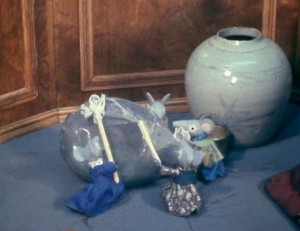
This is made most explicit in ‘The Ballet Shoe’, when they go on strike – although once they are permitted to sing again, their brief rebellion quickly fizzles out. Their song is not protest, but Protestant. Madeleine and Gabriel’s song is more expressive, but no less subordinate to the goal. Only Bagpuss himself never sings.
The birds sang, the proles sang, the Party did not sing.
George Orwell, Nineteen Eighty-four
Baggysattva
Bagpuss was originally imagined by Firmin as an Indian Army cat who visited children’s hospitals and told stories that appeared, ‘as if by magic, in a bubble above his head’ [24]. So he shares his nationality, his military background and his unusually blue eyes [25] with Guatama Buddha. In his stubborn immobility, he recalls Buddha’s 49 days beneath the Bodhi tree [26], at the end of which he attained satori; like a Zen student, Bagpuss knows that enlightenment will surely come to those who sit for long enough. (There’s an explicit link to zazen in Yaffle’s story of the Wise Man of Ling Po, who just wants to sit under a tree on his island, ‘watching the leaves growing’ and bowing to turtles.)
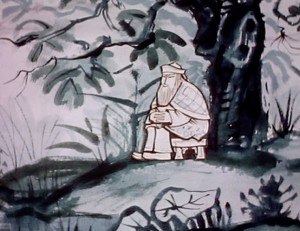
‘Buddha’ means ‘awakened one’, and Bagpuss is, of course, one who wakes. Like a bodhisattva, he returns again and again so he can help his fellow sentient beings awake too. As noted, he and his friends seem to have led previous lives that they have now left behind, and are now reborn afresh with every episode with the task of helping others achieve insight – in the form of the truth about their individual ‘thing’.
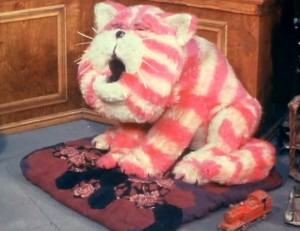
Moreover, Bagpuss’ temperament is serene and slow to anger, as befits a feline roshi:
When my teacher was seventy, he said, “When I was young I was like a tiger, but now I am like a cat!” He was very pleased to be like a cat.
Shunryu Suzuki, Zen Mind, Beginner’s Mind [27]
In his thinking, Bagpuss exhibits a sort of insightful naïveté, or what Suzuki calls ‘beginner’s mind’. Yaffle, the intellectual, invariably reverts to narrow rationality – that is, what Westerners usually mean when they talk about ‘Enlightenment’ thought. We can readily imagine him dismissing a Zen koan, such as the ‘one hand clapping’, as ‘fiddlesticks and flapdoodle’. For their part, Gabriel and Madeleine cling to ancient folk wisdom like Japanese observing Shinto alongside Buddhism [28], while the mice function as a sort of antic chorus, offering pure mischief rather than Zen-master mind bending. So it’s left to Bagpuss alone to ask the simple, basic questions about the origin and purpose of the ‘things’ that motivate the narrative. These fundamental enquiries evoke the Buddha’s quest to understand the truth of existence, which led him to the Four Noble Truths.
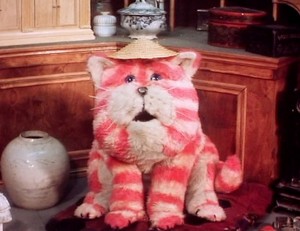
However, the other characters are not just superfluities, or impediments. As well as being Bagpuss’s friends, or acolytes, they are also his faculties; his senses, allowing him to take different views of the ‘thing’. They recall Pig, Monkey and Sandy in Journey to the West [29] (known in English, and televised, as Monkey [30]): they must accompany Bagpuss on his quest for knowledge, because they are aspects of the self that must be acknowledged, disciplined and integrated.
Ultimately, however, their views are subordinate to his; they are synthesised and made useful only through his thinking. In the same way, the Zen student aims to tame their ‘monkey mind’ by taking full responsibility for their thoughts. The rigid order and format of each episode, with its incantory opening and closing recitations, emphasises the value of order, tradition and discipline – familiar to Buddhist monks as routes to insight. When the inner world is ordered, the outer world is also ordered:
When you do things in the right way, at the right time, everything else will be organized. You are the “boss.” When the boss is sleeping, everyone is sleeping. When the boss does something right, everyone will do everything right, and at the right time. That is the secret of Buddhism. [31]
Or, to put it another way, ‘When Bagpuss goes to sleep, all his friends go to sleep too’.
Conclusion
As I hope I’ve shown, there is much more to Bagpuss than whimsical nostalgia. It taught its young viewers to believe in the power of imagination and storytelling. By illustrating the process of imagination, as well as embodying it, it did more to instil a fascination with storytelling than programmes, such as Jackanory, that were completely devoted to story. And it opened a tantalising door to the world of history, culture and music.
For writers, it is an object lesson in not talking down the reader, whatever their level of comprehension, and not being afraid to leave some meaning ‘on the table’ to be picked up through future re-readings. For copywriters specifically, it shows how productive it can be to adopt a vague, allusive tone of voice, even in situations that seem to merit something much more literal and concrete. And for viewers in general, it shows how goals could only be achieved by working together, through kindness and collaboration, by forgiving weaknesses and shortcomings. That’s why Bagpuss endures to this day, and why we, like Emily, love him.
Notes
[1] http://johnfaulkner.net/music/bagpuss/
[2] Oliver Postgate, Seeing Things: An Autobiography, Sigdwick & Jackson, 2000, p.302
[3] See http://www.missing-episodes.com
[4] Postgate, ibid., back cover blurb
[5] Peter Biskind, Easy Riders, Raging Bulls, Simon & Schuster, 1998
[6] On the occasion of a Fawlty Towers reunion. See http://www.theguardian.com/media/2009/may/06/television-john-cleese
[7] https://en.wikipedia.org/wiki/Dad%27s_Army. The programme was originally broadcast from 1968 to 1977.
[8] See discussion at http://www.angelfire.com/scifi/jfm/bagpuss/bagpuss1.htm
[9] Again, see http://www.angelfire.com/scifi/jfm/bagpuss/bagpuss1.htm
[10] https://en.wikipedia.org/wiki/List_of_Winnie-the-Pooh_characters
[11] https://en.wikipedia.org/wiki/Familiar_spirit
[12] https://en.wikipedia.org/wiki/Totem
[13] https://en.wikipedia.org/wiki/Mr_Benn
[14] See discussion at http://www.theheartofhismystery.com/InfiniteRiches.html
[15] Ian Macdonald, Revolution in the Head, Pimlico, 1995, p. 182
[16] https://en.wikipedia.org/wiki/Labyrinths
[17] https://en.wikipedia.org/wiki/Sumer_Is_Icumen_In
[18] https://en.wikipedia.org/wiki/Arts_and_Crafts_movement
[19] http://www.theguardian.com/music/2010/jul/29/bagpuss-folk-roots
[20] http://www.theguardian.com/commentisfree/2008/dec/10/comment-postgate-bagpuss-television
[21] http://www.theguardian.com/tv-and-radio/tvandradioblog/2014/nov/24/bagpuss-clangers-creator-peter-firmin-interview
[22] Postgate, ibid., p.304
[23] Postgate, ibid., p.306
[24] Postgate, ibid., p.295
[25] https://en.wikipedia.org/wiki/Gautama_Buddha#Physical_characteristics
[26] https://en.wikipedia.org/wiki/Gautama_Buddha#Awakening
[27] Shunryu Suzuki, Zen Mind, Beginner’s Mind, Shambhala Publications, 2010, p. 30 (online view)
[28] http://www.japanspecialist.co.uk/travel-tips/shinto-buddhism/
[29] https://en.wikipedia.org/wiki/Journey_to_the_West
[30] https://en.wikipedia.org/wiki/Journey_to_the_West
[31] Suzuki, ibid., p.10 (online view)

